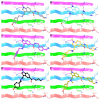Neuroprotective Potential of Indole-Based Compounds: A Biochemical Study on Antioxidant Properties and Amyloid Disaggregation in Neuroblastoma Cells
- PMID: 39765912
- PMCID: PMC11673510
- DOI: 10.3390/antiox13121585
Neuroprotective Potential of Indole-Based Compounds: A Biochemical Study on Antioxidant Properties and Amyloid Disaggregation in Neuroblastoma Cells
Abstract
Based on the established neuroprotective properties of indole-based compounds and their significant potential as multi-targeted therapeutic agents, a series of synthetic indole-phenolic compounds was evaluated as multifunctional neuroprotectors. Each compound demonstrated metal-chelating properties, particularly in sequestering copper ions, with quantitative analysis revealing approximately 40% chelating activity across all the compounds. In cellular models, these hybrid compounds exhibited strong antioxidant and cytoprotective effects, countering reactive oxygen species (ROS) generated by the Aβ(25-35) peptide and its oxidative byproduct, hydrogen peroxide, as demonstrated by quantitative analysis showing on average a 25% increase in cell viability and a reduction in ROS levels to basal states. Further analysis using thioflavin T fluorescence assays, circular dichroism, and computational studies indicated that the synthesized derivatives effectively promoted the self-disaggregation of the Aβ(25-35) fragment. Taken together, these findings suggest a unique profile of neuroprotective actions for indole-phenolic derivatives, combining chelating, antioxidant, and anti-aggregation properties, which position them as promising compounds for the development of multifunctional agents in Alzheimer's disease therapy. The methods used provide reliable in vitro data, although further in vivo validation and assessment of blood-brain barrier penetration are needed to confirm therapeutic efficacy and safety.
Keywords: amyloid; antioxidants; disaggregation; in-cell studies; indole nucleus; neuroprotection.
Conflict of interest statement
The authors declare no conflicts of interest.
Figures






Similar articles
-
Design, selection, and characterization of thioflavin-based intercalation compounds with metal chelating properties for application in Alzheimer's disease.J Am Chem Soc. 2009 Feb 4;131(4):1436-51. doi: 10.1021/ja806062g. J Am Chem Soc. 2009. PMID: 19133767
-
Chromone-lipoic acid conjugate: Neuroprotective agent having acceptable butyrylcholinesterase inhibition, antioxidant and copper-chelation activities.Daru. 2021 Jun;29(1):23-38. doi: 10.1007/s40199-020-00378-1. Epub 2021 Jan 9. Daru. 2021. PMID: 33420969 Free PMC article.
-
Novel neuroprotective pyromeconic acid derivatives with concurrent anti-Aβ deposition, anti-inflammatory, and anti-oxidation properties for treatment of Alzheimer's disease.Eur J Med Chem. 2023 Feb 15;248:115120. doi: 10.1016/j.ejmech.2023.115120. Epub 2023 Jan 14. Eur J Med Chem. 2023. PMID: 36682173
-
Sorghum Grain Polyphenolic Extracts Demonstrate Neuroprotective Effects Related to Alzheimer's Disease in Cellular Assays.Foods. 2024 May 30;13(11):1716. doi: 10.3390/foods13111716. Foods. 2024. PMID: 38890943 Free PMC article.
-
Novel synthetic chalcone-coumarin hybrid for Aβ aggregation reduction, antioxidation, and neuroprotection.CNS Neurosci Ther. 2018 Dec;24(12):1286-1298. doi: 10.1111/cns.13058. Epub 2018 Sep 14. CNS Neurosci Ther. 2018. PMID: 30596401 Free PMC article.
Cited by
-
Metabolomics insights into the protective molecular mechanism of Vaccinium myrtillus against oxidative stress in intestinal cells.Sci Rep. 2025 Mar 13;15(1):8643. doi: 10.1038/s41598-025-93722-x. Sci Rep. 2025. PMID: 40082563 Free PMC article.
-
Untargeted Diversity-Oriented Synthesis for the Discovery of New Antitumor Agents: An Integrated Approach of Inverse Virtual Screening, Bioinformatics, and Omics for Target Deconvolution.J Med Chem. 2025 Aug 14;68(15):16483-16517. doi: 10.1021/acs.jmedchem.5c01344. Epub 2025 Jul 24. J Med Chem. 2025. PMID: 40705771 Free PMC article.
-
N-Alkylamino Stilbene Compounds as Amyloid β Inhibitors for Alzheimer's Disease Research.Molecules. 2025 Jun 5;30(11):2471. doi: 10.3390/molecules30112471. Molecules. 2025. PMID: 40509358 Free PMC article.
References
Grants and funding
LinkOut - more resources
Full Text Sources

